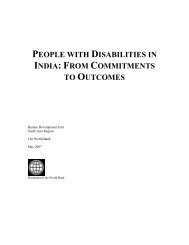FREE Download - TARSHI
FREE Download - TARSHI
FREE Download - TARSHI
You also want an ePaper? Increase the reach of your titles
YUMPU automatically turns print PDFs into web optimized ePapers that Google loves.
attempts are made to limit women's sexual agency. Sheba Chhachhi (1998) offers an example of the<br />
past in the present in her article, Raktpushp (Blood Flower), that explores the polyvalent ways in which<br />
contemporary Indian women look at their bodies, and we see echoes of it, for example, in Amin et al's<br />
(1996) and Grenon and Mawji's (1996) studies on views of sexual illness ('illness of the nether region')<br />
as women and men weave together tradition and modernity to produce a narrative of causation and cure<br />
that makes sense to them.<br />
In contrast again to essentialist notions, social construction theory understands sexuality as being<br />
produced through social, economic, cultural and gender power relations. Sexuality is constructed by<br />
society in complex ways. 'It is a result of diverse social practices, of social definitions and<br />
self-definitions, of struggles between those who have the power to define and regulate, and those who<br />
resist. Sexuality is not a given, it is a product of negotiation, struggle and human agency' (Weeks, 1986).<br />
Women's bodies, in particular, have been the battleground upon which political, cultural and<br />
nationalist/imperialist wars have been waged, with major implications for women's sexual agency. That<br />
these wars are more often fought in the home than across geopolitical boundaries is well-recognised,<br />
making the household one of the main sites where sexuality is produced and negotiated. There are a<br />
number of studies that specifically look at sexuality within the home and whilst some implicitly revert to<br />
essentialist notions of man as provider and woman as home-maker, others offer a much more nuanced<br />
view that explores the ways in which domestic power dynamics serve to produce particular forms of<br />
sexual relation and sexual expression.<br />
The focus on the home as a site of sexual construction is brought out by the negotiational /interactional<br />
approach to sexuality which draws on the conflict/co-operation model proposed by Amartya Sen in the<br />
context of household economics. It focuses on the bargaining power of different members of the<br />
household, and explores factors such as the options facing individuals should cooperation break down;<br />
the perceived significance of their contribution to household prosperity; the degree to which they are<br />
prepared to subordinate their own wellbeing to that of others; and the ability of some members to<br />
exercise coercion, threat or violence over others (Kabeer, 1994). This particular approach has been<br />
helpful in offering a nuanced gender perspective on women's and men's interactions and negotiations<br />
around sexual relationships, both within the family, and in contexts such as sex work. Annie George's<br />
(1998, 2000) work reflects this approach.<br />
The theories of sexuality discussed here could be viewed as Western, of limited relevance to India,<br />
failing as they do to take on the specific formulations of social and economic life and individual identity<br />
formation experienced in India. An argument could therefore be made for developing indigenous<br />
theories of sexuality. But as Mary John and Janaki Nair (1998) argue, the West is at once a particular<br />
geographical place and a relation. Indian feminist theorising on sexuality must address the legacy that<br />
constructs India as the Other of the West, the site of exotic, oriental practices, erotic temple sculptures<br />
and the Kamasutra. John and Nair (1998) argue that the task of theorisation can never take the form of<br />
the application of a theory that one possesses in advance, but must resemble a process, a historical<br />
and political mode of conceptualising sexual economies that would be true to our experiences of an<br />
uneven modernity, calling for multiple levels of analysis and the forging of articulations between the<br />
global and the local. Colonialism and Orientalism are as much a part of the context through which<br />
current day constructions of sexuality must be read, as are sacred texts or current Bollywood movies.<br />
This overview of theories of sexuality serves to offer a perspective through which the review of studies<br />
can be read and assessed. Whilst there are several studies that engage with theory, what comes across,<br />
in the main, is the idea that sex is a 'natural' force unaffected by social forces or by time and place.<br />
These studies restrict sexual behaviour to discrete undifferentiated acts, specifically peno-vaginal<br />
intercourse, and undifferentiated genito-oral and genito-anal sex. Sexuality is seen as synonymous with<br />
sexual behaviour and there is little exploration of its other aspects - fantasy, desire, pleasure, emotions,<br />
6










